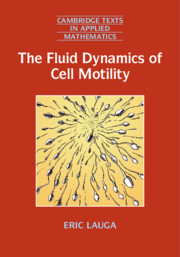Book contents
- Frontmatter
- Dedication
- Contents
- Preface
- Part One Fundamentals
- Part Two Cellular Locomotion
- Part Three INTERACTIONS
- 10 Swimming Cells in Flows
- 11 Self-Propulsion and Surfaces
- 12 Hydrodynamic Synchronisation
- 13 Diffusion and Noisy Swimming
- 14 Hydrodynamics of Collective Locomotion
- 15 Locomotion and Transport in Complex Fluids
- References
- Index
15 - Locomotion and Transport in Complex Fluids
from Part Three - INTERACTIONS
Published online by Cambridge University Press: 09 September 2020
- Frontmatter
- Dedication
- Contents
- Preface
- Part One Fundamentals
- Part Two Cellular Locomotion
- Part Three INTERACTIONS
- 10 Swimming Cells in Flows
- 11 Self-Propulsion and Surfaces
- 12 Hydrodynamic Synchronisation
- 13 Diffusion and Noisy Swimming
- 14 Hydrodynamics of Collective Locomotion
- 15 Locomotion and Transport in Complex Fluids
- References
- Index
Summary
In many biological situations, self-propelled cells and slender appendages interact with complex, non-Newtonian fluids. In this fifteenth and final chapter, we revisit the Newtonian hydrodynamic principles from Chapter 2 for fluids characterised by a nonlinear, or non-instantaneous, relationship between stress and deformation. We first consider linear viscoelastic fluids. We show how the presence of memory in the fluid affects the hydrodynamic forces and the energy of slender filaments, and compare a modified active-filament model of spermatozoa to experiments in viscoelastic fluids. We next address fluids with nonlinear rheological properties and their impact on the locomotion of Taylor's waving sheet. When the wave kinematics are prescribed, the nonlinear fluid leads to decreases in both speed and energy expenditure, which compares favourably to experiments using small nematodes. If instead the wave results from a balance between activity, elasticity and fluid forces, a transition to enhanced motion is possible for sufficiently flexible swimmers. We finish by addressing heterogeneous fluids and show how the multiscale nature of the fluid systematically enhances flow and transport.
Keywords
- Type
- Chapter
- Information
- The Fluid Dynamics of Cell Motility , pp. 315 - 352Publisher: Cambridge University PressPrint publication year: 2020

